 |
 |
|
I'm always a bit hesitant to make recommendations about buying equipment. The reason is that everyone has different shooting styles, existing equipment and let us not forget budget.
What is an ideal M-kit for me may be completely different from your needs.
My recommendation is that you start the process by looking at your favorite images. It might be helpful to sort them physically or mentally into catagories. Here is the hard part. Try to remember what lens you used for each of those images and try to remember the film speed, f/stop and shutter speed used. The purpose of this exercise is to figure out: 1) What focal lengths you have the greatest success with. 2) How fast of a lens you really need. 3) What should be your purchase priorities. |
 |
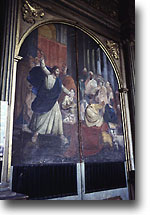 |
You may discover that all of your favorite family portraits are taken with a 90. Your favorite travel/people images with a 135 or 200mm.
Scenics or architecture with a 21mm or 24mm and your pictures of family and friends are taken with a 35mm or 50mm.
You may discover that your favorite images come from either a 35mm or a 90 and you almost never use a 50mm. Perhaps your favorite images are macro shots, in which case the M-system will do you little good. There are so many possibilities based on your shooting style and tastes that it is impossible for me or anyone else to determine what would be best for you without looking at all of your images. Either way you should know what lens suits your needs better than any salesman or stranger on the web. |
|
Once you've figured out what you use and what you need, I'd suggest you think about whether the image could have been done with a different lens or exposure setting or if it would have benefited from something you didn't have.
Would that image have been better if you had used a 24mm instead of the 28mm. Was the image blurry because you had a f/4 lens... would a f/2, f/1.4 or f/1 lens made the picture possible.
Could you have gotten close enough to get that image with a 90mm or 135mm or was it only possible with a 200mm or 300mm lens.
Hopefully you've figured out what focal lengths best suit your style of photography. Now you are ready to start the buying process. |
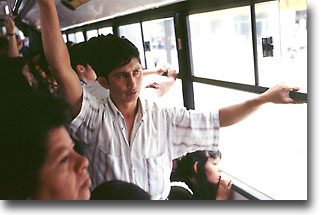 |
 |
The great thing about the Leica system is that there are several generations of lenses that may be used on any M series body. The confusing part is that there are many different versions of lenses that have the same name.
How do you tell the difference? Well... sometimes Leica changed the filter size or added a different hood when they re-designed the lens. But occasionally they left the optics alone and just changed the hood or filter size. Anyway you look at it, identifying Leica lens versions can be rather confusing. |
|
Fortunately there are good resources out on the web for helping you identify Leica lenses and cameras for that matter. These are my five favorite Leica sites.
For information on current products, visit the officialLeica Camera homepage. Erwin Puts has the best site on Leica lenses including reviews and comparisons. Stephen Gandy has a M-Series guide on all Leica M-series bodies. The Leica Historical Society of America web site and publisher of a quarterly Journal. Hans Pahlen's site that includes links to Leica photographers all over the world. |
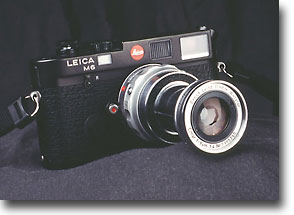 |
 |
Leica began selling rangefinder cameras to the public in 1925. During the following 40 years they sold nearly 800,000 LTM (Leica Thread Mount) cameras. While many of these are now in the hands of collectors, some people still enjoy using them and there are lots of LTM lenses around.
If you really want to play the older optical field you can get adapter rings which allow the use of (LTM) lenses on M-bodies. Actually you can use Canon LTM, certain Minolta, Zeiss, Nikon and "Russian" lenses as well. Prices on those lenses are often far cheaper than the equivalant M mount lenses. In many cases LTM lenses perform admirably as long as you use a good lens shade. But please don't expect those lenses to compete with or out-perform current designs. You can now purchase new Voigtlander LTM lenses by Cosina that can be used via an adapter on M-series cameras. For the extreme wide angle lover, Voightlander offers 12mm and 15mm lenses at very reasonable prices, wow! |
|
The latest generation of Leica lenses take advantage of new technologies and provide superb performance. Some older generations of M-series lenses are still pretty good and if you use them outdoors at f/8 or f/11, you probably wouldn't notice much difference between the two. My personal opinion is to try and buy the latest designs unless you are really pressed for funds. Leica lenses are very well made and will probably outlast you unless you really abuse them. But it can be suprisingly fun to use classic cameras and lenses too. |
 |
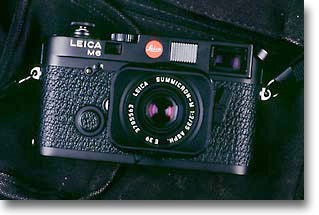 |
Leica equipment is rather expensive though, so you want to make your purchases wisely. I'd suggest you buy a Shutterbug magazine and look at some of the dealers who sell things over the web to get an idea of prices. So what should you buy? Well if I was going to buy one camera and one lens, I'd buy a M-6 and a 35mm f/2 Summicron ASPH. If I had to recommend a basic 3 lens M-series kit for general shooting... I'd recommend a M-6, 35mm Summicron (either last generation or ASPH version), 50mm Summicron and 90mm Summicron. After that, I'd add a second M-6 and a 21mm or 24mm lens. And if you need a truly fast lens, The 50mm f/1 Noctilux may be the lens for you...I keep telling myself that I need one... But it really depends upon your shooting habits and your budget. |
|
There are lots of Leica M-series cameras on the used market and you can save some money by buying earlier models. The first Leica M-series model was the M-3. Even though the M-3 is some 40 years old, it can be a perfectly usable body. The M-3 has the highest magnification of any of the M-series bodies and I prefer it over the M-6 for use with the 90 and 135mm lenses. The M-3 doesn't have framelines for anything wider than a 50mm lens though.
The M-2 is similar to the M-3 but has framelines for 35, 50 and 90mm lenses. The thing I don't like about the M-2 and M-3 is that they are chrome bodies and the rewind knob is well...... a knob.
I tend to get to the end of a roll a film before I'm done shooting any particular subject so I like to rewind and reload as quickly as possible. So I prefer later models with rewind cranks. Anymore it's hard to find a M-4 or M-5 for a reasonable price... so many users have latched on to the either the M-4 2 or M-4 P cameras. The M-4 2 has framelines for 35, 50, 90 and 135. The M-4P adds the 28mm and the 75mm framelines but neither one has a built in meter. |
 |
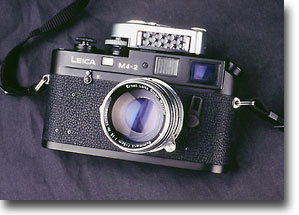 |
You can buy MC, MR or MR-4 meters that fit on the hot shoe of either camera. But you have to pick between using it or an accessory wide angle viewfinder as there is only space for one at a time. I'd recommend you buy a nice handheld meter instead.
The M-6 has frame lines for the 28,35, 50,75, 90 and 135 and a built in lightmeter. The M-6 HM (High Magnification) is easier to use with longer lenses but lacks a built-in frame for the 28mm. |
|
Are M-series Leicas really worth it? That is a hard question to answer. While the quality of Leica lenses is generally superior to the competition, the quality difference isn't always obvious depending upon ones technique or normal shooting conditions.
Just because a lens renders fine detail better or is free from flare or reflections doesn't mean that one will prefer images taken by it over those taken by another system. Even when there is a visible difference between lenses, some have a hard time justifying the considerable cost difference for a "marginal" improvement.
The Leica M system contrasts the latest AF motor driven SLRs as it is a small and quiet rangefinder camera. I personally feel it makes a great companion system to an SLR kit. Leica's precision construction will allow many years of regular service and the resale value is quite high. So the actual cost spread over the life of the camera may be less than buying a cheaper camera that gets replaced every 5 or 6 years. If you can live with the limited range of lenses available for it, the minimum focusing distance and you can afford the initial investment in the system, it certainly doesn't get any better than a Leica. |
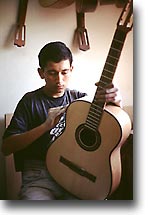 |